Sir Stirling Moss has been hailed as being “the greatest racing driver never to win a Formula 1 World Championship.” This despite coming precariously close at times throughout his career. His natural ability shone through when he was most up against it – but how did a Ferrari deal that fell through, catapult him to be one of the sport’s all-time greats?
He was a fine example of a British racing driver who loved the sport and although ill-health brought a stop to his public appearances, everyone still thought of him through his surgeries, one of which was at the Royal London Hospital in East London when he was 80.
London-born Moss was one of the leading lights within British motorsport in the late 1940’s and early 50’s, even though his Father, Alfred Moss, was at first reluctant in letting him race as he wanted him to become a dentist.
However, through constant pestering, Moss finally got his wish. He recalls the discussions he had with his Father in a BBC interview first aired in 1960.
“My Father said to me, ‘No, you can’t have a racing car, but you can have a sports car,’” said Moss. “So, I got a sports car when I was 17 and had reasonable success”
The car in question was a BMW 328 which his Father had bought from a fellow dentist, Victor Biggs. Moss would later admit that it was ‘a great little sports car’ in which he ‘learned a great deal.’
Just a year later however, Moss sold the BMW and used the money to buy his first racing car, the Cooper-JAP 500 MKII.
“I managed to drag my Father over to a racing car manufacturer’s garage, where I showed him this car,” he explained. “He tried it on, and I tried it on, and I think he felt the bug as he’d done it (racing) before. He agreed that if I sold the sports car and used the money, then I could buy this other one.”
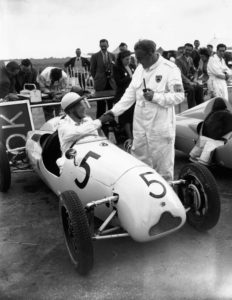
Moss quickly impressed not only the British public with his natural driving ability, but also the rest of the world too. He took a number of wins in the 500cc Formula 3 class and even made his British GP debut in 1948, racing in the support category at the age of just 18.
Having qualified on the front row of the grid, Moss soon found himself leading until an engine issue forced him to retire.
Moss would win many races in the 500cc Formula 3 class, but it would be a Sports Car race in 1950 that would see Moss get his breakthrough on the International stage.
Jaguar Gives Moss His Big Break
The Dundrod RAC Tourist Trophy was a classic race that Moss desperately wanted to take part in. However, due to his inexperience, no manufacturer would give him a drive, until one man called Tommy Wisdom came along.
He told Moss that they could share his car fifty-fifty, and that was exactly the break a young Moss needed.
Driving a Jaguar XK120, Moss led from the start and won the race with an average speed of 75.15 mph (121 km/hr) leading home a Jaguar one, two, three.
His self-proclaimed greatest asset was that he could drive at high speed over a long time – something which came in handy for these long endurance races. Moss once said; “If you ease off for a fifth of a second, you may drop from first to sixth-place. Therefore, you’ve got to keep the pressure up all the time. I can concentrate without necessarily having to think about it.”
That win brought him to the attention of Jaguar founder, William Lyons who invited Moss to lead the Jaguar team in 1951.
Moss was delighted and would go onto claim four more wins for the manufacturer the following year, including retaining the RAC Tourist Trophy.
Moss was the first British professional racing driver which meant, according to Moss, ‘he would have to go fast.’
“A professional driver has to go fast, whether he’s got a stomach-ache or not,” said Moss.
“If he gets into a car, he’s expected to go quicker than any other amateur has gone before – whether or not he knows the car or knows the circuit – it doesn’t really matter. You are expected always to give your best.”
With Moss now being the very best Britain had to offer to the Motorsport world, he would soon attract the attention of one of the biggest and most powerful motor racing dynasties. However, his Ferrari dream was about to become a nightmare.
Ferrari Deal Falls Through
Ferrari were and have been since, one of the biggest manufacturers in Motor Racing history with Formula 1 World Championships and wins at the prestigious 24 Hours of Le Mans being some of many highlights for the Italian marque.
Enzo Ferrari was a big presence within the racing scene and having seen Moss win for Jaguar, in August 1951, asked him to race for Ferrari in Formula 1.
Moss was just 21 years of age – which was a big deal in itself – let alone being the first Englishman to have been given the opportunity to drive for the prancing Horse badged Italian giants.
The bright, young British talent drove down to Bari with his Father to complete the deal, full of excitement and enthusiasm. However, that was to be short-lived as when they arrived, they found out that Enzo had backed out on their deal and had instead given the drive to veteran Italian driver, Piero Taruffi.
Speaking in 1963, Moss recalled the ordeal; “I went all the way down to Bari in Southern Italy with my Father, being thrilled. You know, that I had been asked to go and drive for Ferrari – this is really the thing.”
“When we got there, I found that the car had been given to Taruffi and not that I felt anything about Taruffi, I don’t blame him but I think they might of cabled me and said, ‘Look, Mr Taruffi’s got the car.’ I was pretty annoyed. I wouldn’t say it hurt me, but it sure got me fired up,” he chuckled.
Grand Prix Debut
Moss would make his F1 debut in 1951 at the Swiss Grand Prix for the Hersham & Walton Motors team, piloting their HWM 51-Alta. He finished in eighth position after the car ran out of fuel on the line.
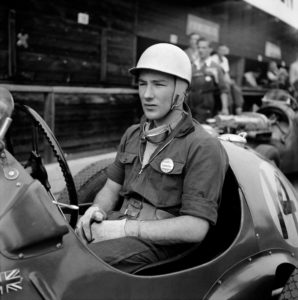
After a frustrating 1952 season in which Moss continued to drive for Jaguar – securing six more wins along the way – his Formula 1 career was struggling to mount the same momentum. He made five Grand Prix starts that year, all of which he retired from.
This frustration was perhaps further compounded by the fact that Taruffi ended up finishing third in the drivers’ championship, taking a win at the season opening Swiss Grand Prix – the same race at which Moss made his F1 debut a year prior.
Aside from the racing side of things in 1952, Moss (along with; Leslie Johnson, Bert Hadley, and Jack Fairman) drove a Jaguar XK120 FHC LWK 707 at over 100mph for seven days and seven nights consecutively, in a record-breaking run.
1953 would see Moss secure his best ever finish at the historic 24 Hours of Le Mans at the wheel of the Jaguar C-Type which he shared with Peter Walker. He would also go on to finish sixth at the German Grand Prix with Cooper, securing his best result in Formula 1 to date in what was another largely frustrating season.
Although 1954 followed a similar trend in terms of results and unluckiness, his raw speed and ability behind the wheel was to be admired.
The racing manager of Mercedes-Benz, Alfred Neubauer was impressed with how Moss was conducting himself within the racing scene and signed him to partner the iconic Juan Manuel Fangio in both Formula 1 and sports car racing.
This would allow Moss to further announce himself on the world stage and elevate him to be the racing driver we all knew and loved him being.
Into The History Books
The 1955 campaign would see Moss write his name into the history books twice more with historic wins at the British Grand Prix and at the Mille Miglia.
Fangio would dominate the season, winning five of the seven events held that year, but Moss’ victory at Aintree would see him become the first ever British driver to win the British Grand Prix.
There have since been some debates about whether or not Fangio ‘let’ Moss win the Grand Prix, but no one can take away the triumph from the British driver as he secured his first World Championship win.
Moss would eventually finish second in the championship that year, but he would be victorious in the world of sports cars after a memorable campaign with the German manufacturer.
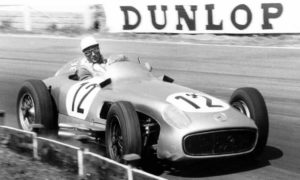
The Mille Miglia was a 1000-mile non-stop race around Italy’s closed public roads. It was renowned for being one of the toughest motor races at the time and was always considered to be impossible to win without some sort of local knowledge, with only two non-Italian drivers ever winning the race prior to 1955.
It was an incredibly dangerous race and notoriously tough for all competitors and their cars.
Moss teamed up with motoring journalist Denis Jenkinson for the event, who had very little racing experience and certainly very little racing knowledge, which perhaps made their victory all the more remarkable.
Together with Jenkinson, the pair devised a strategy in which Jenkinson would sit in the passenger seat and tell Moss in detail about every corner and hazard on the course as they were coming up to it, through hand-gesturers alone.
They called it ‘the bog-roll’ as the notes were written on toilet paper with a scroll attached to it to make it easier for Jenkinson to scroll through as Moss pounded round.
It was an ingenious solution to make up for the lack of knowledge amongst some increasingly stern competition.
Moss and Jenkinson covered the course in 10 hours and seven minutes, finishing over 30 minutes ahead of the second-placed Ferrari with an average speed of 99mph.
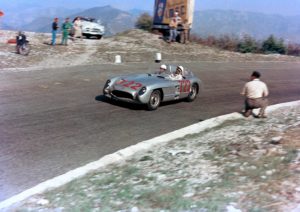
In the same years, Moss also won the Targa Florio with Peter Collins, helping secure Mercedes-Benz the World Sportscar Championship by just a single point from Ferrari, perhaps making the year all the more sweeter.
Traits Of Moss
One of Moss’s biggest traits was driving quickly over a long period of time, making him one of the best drivers in both sports cars and Formula 1.
Owing to the tragedy at the 24 Hours of Le Mans in 1955, in which 83 spectators plus Mercedes-Benz driver Pierre Levegh were killed, the German manufacturer pulled out of motorsport at the end of the season.
Moss would sign for Maserati ahead of the 1956 season, securing two victories at the Monte Carlo Grand Prix and the Italian Grand Prix at Monza, as he finished second in the standings for the second consecutive year.
Another one of Moss’ traits was taking a privateer car and beating the manufacturers.
He once said: “If you can take a private car and then beat the factory with their latest cars, then it is far more exhilarating.”
Moss had always wanted to race for a competitive British team in Formula 1 and so ahead of the 1957 championship, left Maserati to join Tony Vandervell’s improving Vanwall team.
Moss took three wins that year as he finished second in the championship to Fangio for the third year on the trot.
Moss won the British Grand Prix again, two years after becoming the first British driver to win the race, after he took over from the ill Tony Brooks, having retired his own car earlier on. He would also win the Psecara Grand Prix and the Italian Grand Prix too.
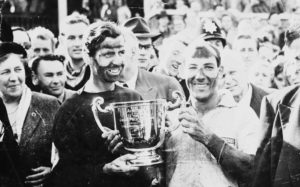
With Moss’ arch rival Fangio semi-retiring at the end of the 1957, he became a firm favourite for the 1958 title.
The Vanwall squad missed the start of the season as they were struggling to make their engines competitive using the commercial aviation fuel. Moss would enter the season opening Argentinian Grand Prix with the Rob Walker team, driving their Cooper T43-Climax.
He would win the Grand Prix, surprising the Ferrari team by not stopping to refuel.
With the Vanwall cars ready, the season would develop into a titanic battle between Moss and Ferrari’s Mike Hawthorn as they battled for the World Championship crown.
Respect
With Moss seemingly being let down by poor reliability numerous times throughout the season, by the time the Portuguese Grand Prix came around, the championship could have gone to either of them.
Hawthorn led the Grand Prix but when his Ferrari stopped, he restarted his stricken Ferrari by pushing it the opposite way down the track before jumping back in and completing the race.
Moss took the race win and the chequered flag.
The stewards subsequently disqualified Hawthorn post-race with Moss securing his third race win of the season as he looked to clinch his first F1 World Championship.
However, Moss was angry with the stewards’ decision and told them that Hawthorn had done nothing wrong. The stewards were convinced by Moss’s argument and re-instated Hawthorn, who was classified second in the official result as he joined Moss on the lap of honour.
Brooks said, “It was very, very sporting of Stirling to defend Mike. I don’t know any other driver, frankly who would have done that for anybody.”
Hawthorn would eventually go on to win the Formula 1 World Championship by just one single point, despite Moss winning more races than him that season.
It was the fourth year in a row that Moss finished second. If it wasn’t for his sportsmanship, he would have won the World title.
He took four race wins that season, in what would be the closest he would ever come to clinching the title. It wasn’t all bad though, as Moss helped the Vanwall team win the inaugural constructors World Championship, beating some of the biggest manufacturers in the world.
Vanwall would subsequently pull out of the sport at the end of the year. For 1959, Moss joined Rob Walker’s team. As the Cooper T51-Climax struggled with gearbox issues throughout the campaign, Moss finished third in the standings.
Moss remained with the outfit for 1960 and brought the marque its first Formula 1 race win with victory at the Monaco Grand Prix. An accident in practice at the Belgian Grand Prix saw Moss suffer fractures to both of his legs and back, although he would return before the end of the season.
He won the United States Grand Prix as he finished third in the championship for the second consecutive year.
1961 would be a memorable season for Moss as he secured, perhaps his finest Grand Prix victory – in which he exemplified his love of being an underdog and racing the manufacturers in a vastly weaker privateer car.
Moss As An Underdog
With new rules and regulations coming into effect for the 1961 season affecting some teams’ preparations, Ferrari were expected to dominate proceedings with their ‘shark-nose’ 156.
However, at the season opening Monaco Grand Prix, there would be a shock on the cards.
Moss’ Rob Walker Lotus-18 weighed less than 450kg’s and had around 150bhp – it was a machine dedicated to lightness and speed rather than safety itself. Compared to the Ferrari’s, the car was outdated and didn’t have the speed or aerodynamic capabilities to that of its Italian rival.
To further help their cause, Moss requested that the side panels were removed to allow for more ventilation into the cockpit, leaving him even more vulnerable to the perils and dangers of the Monaco streets.
Ferrari entered three cars into the race, and so Moss, nor anyone else was expected to challenge the might of the more aerodynamic and powerful Ferrari’s, with the three cars expected to all finish on the podium.
However, Moss was eager to show the Italian’s up and put in a scintillating lap time of 1min. 39.1seconds to put himself on pole position for the start of the Grand Prix.
It was Richie Ginther who led the field away as Moss slipped to second behind Jim Clark, before overtaking him again as a result of a mechanical failure caused by a trapped wire under a frame tube.
Ginther’s start had the whole field shaken as he sailed off into what many thought would be an unassailable lead. However, Moss wasn’t giving in and by lap eight, had whittled the gap down to just 1.5 seconds.
On lap 14, Moss made his move and overtook the American to take the race lead. Moss was then able to get into his rhythm and opened up a six second gap ahead of Porsche’s Jo Bonnier who also overtook the now struggling Ginther.
Moss was able to keep the Ferrari’s at bay as he refused to let the much stronger car win – he was consistently quick over a long period of time and refused to relinquish the race lead.
The Ferrari’s closed in as the race reached it’s close but Moss used every single bit of his Lotus to keep them behind, maintaining a gap of five seconds. He was lapping the slower cars as if it were for position, absolutely flat-out with no quarters given.
Moss was on the absolute limit – which was another one of his traits – he was lapping faster than he did in Qualifying lap after lap and was loving the battle. The menacing looking Ferrari’s looked like they were ready to pounce should Moss make a mistake, but he continued to keep his cool.
At the chequered flag, Moss led the Ferrari of Ginther home by just 3.6 seconds as the new era of Formula 1 got under way.
It was a race win that exemplified everything that Moss was about; being constantly quick, driving clean, and making no mistakes over a long period of time.
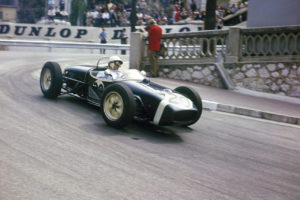
Moss did win again, at the German Grand prix as he perfected the tyre choice in a race with changeable conditions. The season was dominated by the Ferrari’s with the Italian marque winning five of the eight events that year as Phil Hill became the first American Formula 1 World Champion.
Moss would finish third in the championship yet again, as he once again caught the attention of one Enzo Ferrari, but once again his dream would be denied, as one of his biggest traits became the biggest adversity of his motor racing career.
‘It Was A Place I Should Have Never Gone Off At’
Enzo was impressed with how well Moss was doing against his Ferrari team in privateer cars and offered him a drive for the 1962 campaign.
Intrigued by what he had to say, Moss agreed to speak to him and when he arrived to speak to Enzo, he was greeted like royalty. A big contrast to what had happened all those years before.
Moss requested that he wanted the Ferrari’s to be painted Blue, like his Lotus. The famously stubborn Enzo agreed to this and so the deal was agreed – Moss was finally a Ferrari driver.
However, before the season got underway, Moss was racing in the Glover Trophy race at Goodwood for Formula 1 cars. He was chasing the fastest lap before he went cascading off and into the bank at well over 100mph. His Lotus folded around him, but thankfully didn’t catch on fire.
Moss would later admit, “It was a place I should have never gone off at.”
He smashed his face, skull and both of his legs and was in a coma for the next six weeks. Not just the motor racing world, but the world itself was in shock, as to what had happened to this British racing driver.
Amazingly, he returned to the cockpit a year later with Lotus, in a private test at Goodwood despite some of his dearest family and friends being apprehensive to say the least.
Although his lap times were still quick, they were not ‘Moss quick’ as he found that his lap-times were slower than ever before. He had loss that touch he had once had, that enabled him to connect with whatever car he was racing in at any track in the world.
He retired immediately at the age of just 32, having never raced for Ferrari and never winning the Formula 1 World Drivers’ Championship.
Racing Is Dangerous
Motorsport was and will always be dangerous – Romain Grosjean’s recent crash at the Bahrain Grand Prix proves that, but in Moss’ era, it was even more dangerous.
For every five years someone raced in Formula 1, there was a 75% chance you could be killed, Moss raced in Formula 1 for 10.
He survived big crashes throughout in his career, the Belgian Grand Prix crash in 1960 being one in particular, as well as the aforementioned 1962 crash at Goodwood, which was the biggest. But he bounced back from them– still with that determined racing style that has since become synonymous with him.
Although from the outside, it may have seemed that Moss wasn’t frightened, he explained in a 1960 television interview that this is not the case and explained the difference of being frightened and having fear.
“I don’t think about it (fear) when I’m driving,” he said. “But I am frightened of death. I think it helps every driver to be frightened, because if you’re not frightened of an accident, then what is your limitation?
“It’s something that when I’m driving around of course, the less I overdo it or go too fast, the less I’m frightened. I wouldn’t ponder on the thought.
“Fear is a lack of understanding of what’s happening.”
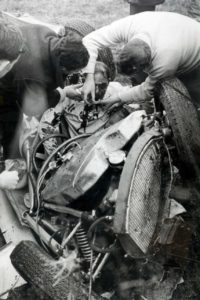
Moss used the banks of Monza as an example of this, where the car would be at an 80°angle and as a result, be more susceptible to damage or mechanical failures.
“It concerns me seeing other drivers crash because most of the time we know who they are. Equally of course, you mustn’t let this worry you or affect you as if you let it worry you, you are much more of a danger to yourself.”
Although Moss was fearless behind the wheel, he was aware and frightened of the consequences of crashing a Formula 1 car at high speed.
His professional racing career ended with over 200 victories across a multitude of different classes and races: from sports car races, Formula 1 races and endurance events too, as well as world record attempts.
Moss always said that the mind would go before the body, but it was as a result of his body going, where his mind also went that forced him to retire from motor racing.
After his crash at Goodwood, he was no longer able to defy the odds – although he did make many more racing appearances before he stopped at the amazing age of 81. He then retired from public life in January 2018.
Moss once said; “Racing has brought me much happiness, but also a lot of unhappiness over the years.”
He transcended and forged the pathway for many more young aspiring British racing talents, like: Jim Clark, John Surtees and Sir Jackie Stewart.
As much as it would have been amazing to see him drive for Ferrari, his traits and love for the sport wouldn’t have come across so fluidly and he arguably wouldn’t have been as memorable to what he is now, for any motor racing fan.
His love of being the underdog and defying the odds sought him admirers from all over the world, and that is when his natural racing ability shone through best.
His passing on April 12th of this year at the age of 90 sent shockwaves through the motor sport world, but his remarkable career shall always be remembered.
Header image courtesy of Bernard Cahier/Getty Images.



